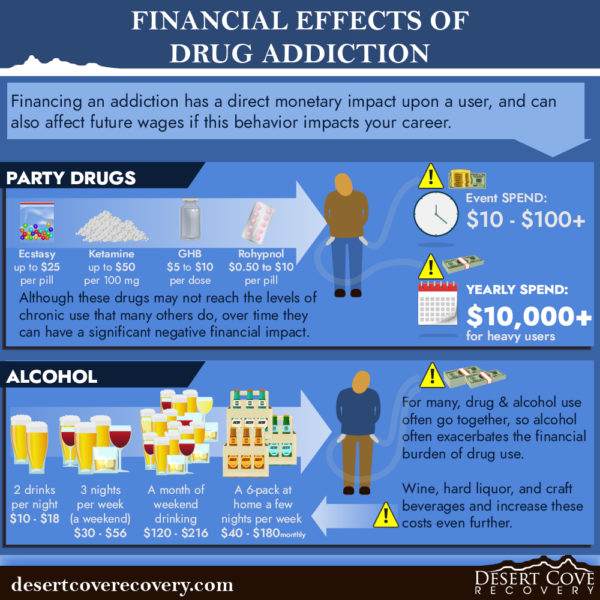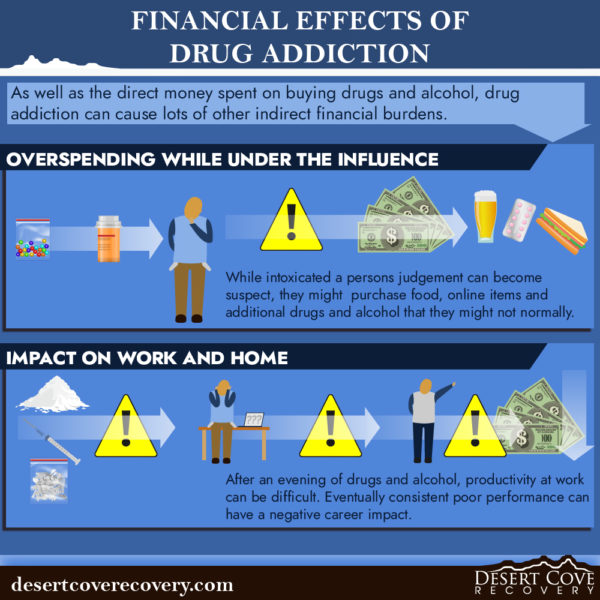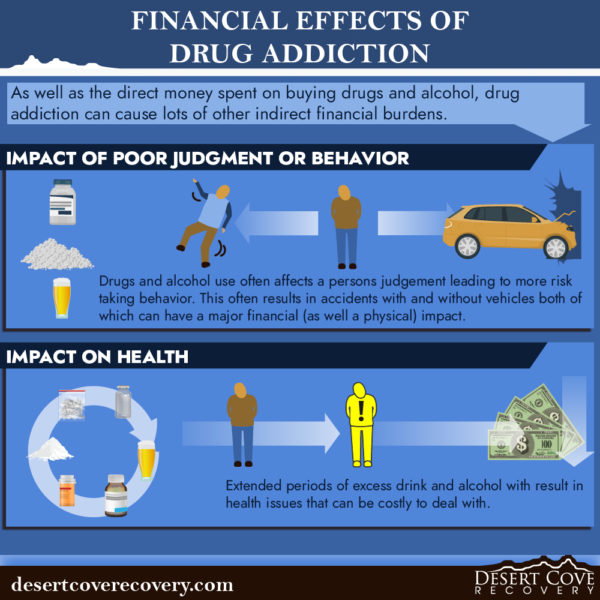Drug addiction has a lot of costs, including friends, family, and future career goals. But what about the financial effects of drug addiction? Drugs aren’t cheap, and some people may find that they’re spending hundreds each day on the drugs to fuel their addiction, if not more.
Along with the emotional and social costs of addiction, substance abuse and addiction take a toll on the user’s finances. Financing an addiction has direct monetary costs and a loss of future wages if the behavior impacts the user’s career prospects.
Financial Costs of Illicit Substances
Different illicit drugs have different costs, especially if purchased “on the street” or on the black market. Many of these drugs are in high demand and therefore harder to source and more expensive to obtain.
Here are the standard costs of illicit drugs:
Opioids
In response to the growing opioid epidemic, the Centers for Disease Control outlined new clinical practice guidelines for prescribers to reduce the number of people who misuse or overdose on these drugs.1
According to the crowdsourcing research website StreetRx, black-market drugs command the following prices:2
- OxyContin: up to $80 per pill for 20 mg
- Percocet: up to $40 per pill for 10 mg
- Vicodin: up to $10 per pill for 10 mg
- Dilaudid: up to $25 per pill for 8 mg
Based on these values, a person with an opioid tolerance may spend $200 or more each day on painkillers, which comes out to about $73,000 per year. As an alternative, some users may opt for heroin. However, tolerance for heroin develops quickly, so users may find themselves spending as much or more than they would on prescription opioids.
Cocaine
Retail cocaine prices can vary by drug purity levels, drug source, and location, but a pure gram of cocaine may cost around $165.3
Cocaine is often cut or diluted with other substances, making it more challenging to determine the real purity and subsequent costs. People with a high tolerance and extended cocaine use may consume a gram or more a day, which may cost around $150 per day or $55,000 per year.
Serious users may use even more cocaine each day, potentially maintaining an addiction at thousands of dollars per day and hundreds of thousands or over a million dollars each year.
Methamphetamines
Methamphetamine is in high supply, but it still has costs. Depending on the purity and source, a pure gram of methamphetamine may cost around $58, but it can cost much more. The average light user may consume about 15 mg of meth each day, but those with tolerance may approach three or four times that amount each day.4
Considering these numbers, a heavy meth user may have an addiction that costs over $40,000 a year.
Benzodiazepines
Also known as “Benzos,” benzodiazepines are abused for their depressant effects.
- Xanax (alprazolam): $3 to $5 per pill5
- Valium (diazepam): $2 to $7 per pill6
- Ativan (lorazepam): $1 to $4 per pill7
While these prices may seem low, users may take several pills daily. Benzodiazepine addiction can approach $60 each day or over $21,000 each year.
Party Drugs
While these drugs may not reach levels of chronic use, party drugs used for fun night-out experiences have high costs. These drugs are used mainly for their aphrodisiacal or hallucinatory effects.8
- Ecstasy: Up to $25 per pill
- Ketamine: Up to $50 per 100 mg
- GHB: $5 to $10 per dose
- Rohypnol: $0.50 to $5 per pill
Alcohol
For many, drug use and alcohol use go together. Alcohol can exacerbate the financial burden of drug use, and both alcohol and drug addiction may play off each other.
If you assume two drinks a night at $5 to $9 a drink, just three days a week (typical weekend), alcohol can cost between $120 and $216 a month. Drinking at home with a six-pack of beer, which is about $5 to $15 a few times a week, can cost between $40 and $180 a month. Wine, hard liquor, and craft beverages can cost even more.
Indirect Financial Effects of Drug Addiction
Aside from the direct money spent on buying drugs, drug addiction has numerous indirect financial burdens.
For example, while drinking, people may be inclined to buy rounds of drinks for friends, shop online, or buy food and snacks. Assuming the user goes to work the following day and doesn’t call off sick for a hangover, productivity may suffer and put their job at risk. The same can be said about drug use, increasing impulsivity, and impacting decision-making.
There are also health impacts. In addition to expensive health problems that can arise from extended periods of drug use or alcohol use, people under the influence of drugs and alcohol can behave recklessly and get into accidents, both on their own and with a vehicle.
Finally, if a user gets into legal trouble due to drinking or using drugs, they could end up spending thousands of dollars on legal representation, fines, and other legal fees.
What Are the Financial Effects of Drug Addiction For You?
If you or a loved one struggles with alcohol or drug addiction and suffering the financial or lifestyle impact of addiction, it may be time to seek professional help. Contact Desert Cove Recovery today to learn more about our treatment programs and get on the road to recovery!
Sources:
[1] https://www.cdc.gov/opioids/providers/prescribing/guideline.html
[2] https://pubmed.ncbi.nlm.nih.gov/23956042/
[3] https://www.dea.gov/sites/default/files/2021-02/DIR-008-21%202020%20National%20Drug%20Threat%20Assessment_WEB.pdf
[4] https://www.dea.gov/sites/default/files/2021-02/DIR-008-21%202020%20National%20Drug%20Threat%20Assessment_WEB.pdf
[5] https://portal.ct.gov/DCP/Drug-Control-Division/Drug-Control/Alprazolam
[6] https://portal.ct.gov/DCP/Drug-Control-Division/Drug-Control/Diazepam
[7] https://portal.ct.gov/DCP/Drug-Control-Division/Drug-Control/Lorazepam
[8] https://www.aafp.org/afp/2004/0601/p2619.html









